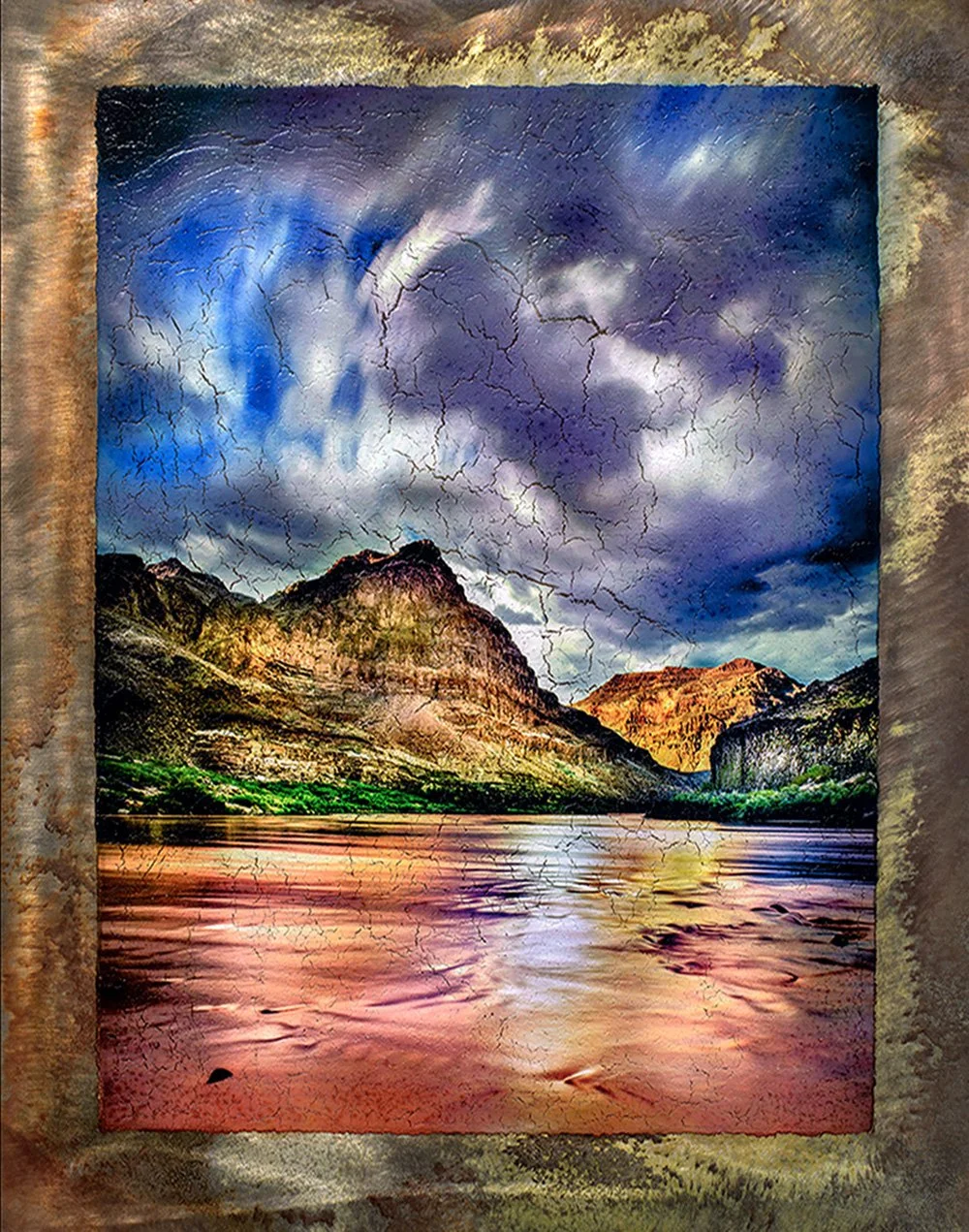Redwall Cavern Panorama, Mile 34, Grand Canyon, AZ. (pigment print, 36” x 60”, mounted on steel panel with UV Varnish)
THE GRAND CANYON: LAND OF FORGOTTEN DREAMS
In 2010, Werner Herzog created the documentary film “Cave of Forgotten Dreams”. The film depicts Chauvet Cave in Southern France, which contains the oldest cave paintings ever discovered, some dating back 32,000 years. Among the paintings are some of the most sophisticated and powerful animal paintings ever made. The undulating cave walls seem to burst with depictions of the life and energy of many long extinct Paleolithic animals. Due to a rockfall that blocked the cave entrance thousands of years ago, the colors and textures, even footprints of animals and people, all is nearly perfectly preserved. Herzog said this in his narration: “These images are memories of long-forgotten dreams. Will we ever be able to understand the vision of the artists across such an abyss of time?”
Pancho’s Cave, below Deer Creek, Grand Canyon, AZ (pigment print, 28” x 60”)
Moonrise with Sunset Light on Cliffs, Saddle Camp looking downstream (pigment print, 30” x 40”)
Near the end of the film Herzog recounts the story of an ethnographer who was working in Australia studying aboriginal rock art. The ethnographer was working with an aboriginal guide who was showing him historical rock art sites and at one point they came upon some rock paintings that were very beautiful but also badly decaying, and the guide made them stop so he could gather materials and he began to touch up the paintings. The ethnographer asked him “Why are you painting?” The guide answered “I am not painting, that is hand, only hand, is spirit that is actually doing the painting now”. How foreign that seems to us in Western culture, that spirit could create art, inhabit a place, suffused in it’s human and more-than-human inhabitants. To the aboriginal mind it is this quality of spirit, the life that permeates all, that is the artist more so than any one individual. Researchers have found through carbon dating that most of the cave paintings in Chauvet were added to and painted over many times, sometimes thousands of years apart. It seems their art was a collaborative, community endeavor, not the solitary, individualistic pursuit it has become in our age.
Grand Canyon 180 degree Upstream and Downstream Panorama, from Nankoweap Anasazi Granary Overlook, Mile 53, Grand Canyon, AZ (mixed-media pigment direct printed on distressed paint surface on aluminum panel, 30” x 60”)
History books tell us that the Grand Canyon was “discovered” by the geologist and explorer John Wesley Powell in 1869, that he was the first person to take an expedition down the Colorado River through the Grand Canyon. His expedition may have well been the first to go the entire length of the Canyon in boats, but he certainly did not “discover” the Grand Canyon. Indigenous Native Americans had been living in and crossing the Canyon for thousands of years. Their traces can be found throughout the Canyon, from the remnants of their stone granaries carved into the cliff faces high above Nankoweap to their trails, rock art, and traces of their agriculture in the bottomlands along the river.
North Canyon, Mile 20, Grand Canyon, AZ (pigment print, 36” x 36”)
Our culture seems to have forgotten how to actually live in a place, to be as much a part of that place as the stones, the water, the plants and animals. We have made the Grand Canyon a National Park, which is good as far as it goes, otherwise it would by now have been turned into a backed up motorboat playground / reservoir like it’s sister canyon upstream, Glen Canyon behind Glen Canyon Dam. We make the places we treasure off limits to any humans actually living there, it seems to be the only way we know of to preserve unique places like the Grand Canyon. If we live in a place we invariably feel we can improve on what nature has created, “develop” it for the benefit of humanity.
Night and Day, Eroded Rock in River Looking Upstream, Owl Eyes Camp, Mile 180, Grand Canyon, AZ (pigment print, 30” x 20”)
I have been lucky enough to have been on seven river trips down the Grand Canyon since 2008, two week trips kayaking, rafting, living and working on photographs day and night. As I have gotten to know the Canyon I have come to realize how special it is to spend time in a place where the world goes about it’s business as it has been doing since time immemorial, where humans are just ghosts passing through. As you descend downriver you go through rocks over a billion years old, walk on fossils as old as time, undersea creatures etched into stone. Geologists who study the ages of the rock walls say the entire history of the human race on earth could be compressed into less than one hundred feet of cliffs that tower thousands of feet overhead. It gives one pause. It first makes you realize how insignificant you are, then as you spend more time there you realize how all the rock and water and complexity of life is the same life that is flowing through your veins.
Approaching Stormclouds Near Whitmore Wash, Mile 192, Grand Canyon, AZ (mixed-media pigment direct printed on distressed paint surface on copper panel, 36” x24”)






